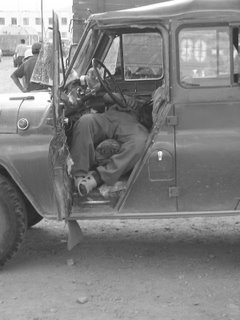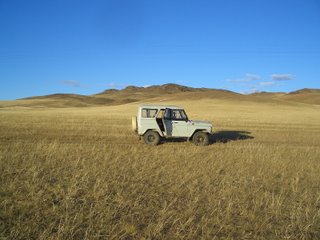See, there’s two things about
Granted, it’s far away depending on where’s you’re standing, and it’s big compared to smaller things, but when you combine the two, that’s when you get a Mongolian outlook.
So there you are, looking around Mongolia and thinking such deep thoughts as “man it’s big” and “wow it’s far away”, and while your understanding of these concepts will vary depending on what kind of viewing platform you stand upon and what kind of shaded goggles you are squinting through, one thing seems certain. If you’re going to move around Mongolia, you will need a conveyance. In a word, a car.
Not just any car. Oh no. Many of your new fangled rides with their drink holders and in-seat heated bottom massagers are poor choices for the Mongolian milieu. Humvees may prowl the streets of Ulaanbaatar, but these are only vehicular bling, the equivalent of 4WD stiletto heels. Their mileage is so poor and Mongolian gas stations so far apart that taking them farther than the hairdressers is a journey fraught with peril. Plenty of Rovers, Cruisers, Troopers and Patrols exist, but if a widget pops lose from its housing when you hit a camel or something, good luck contacting your nearest dealer to help you out with the parts. So what then is the intrepid Mongolian warrior, weekend or otherwise, to drive?

While you are savouring the fluid lines of the bodywork, marveling at the hardiness of the steering rack or just feeling oddly aroused by the steering wheel, a bit of history for you.
 Anyway. Mostly, if you’re referring to one of these beauties in English, you’d call it a Russian Jeep. Or in Mongolian, a 69 (jahren youse, viewers), which is the model number- you know, just in case Uaz is too unspecific for you (not that there are other models, but still.) So Russian jeep UAZ 69 it is. No other ride comes close to being so vital to the country. The Uaz equivalent of a VW bus, the furgon, plays a part certainly, but all others are simply cars. The Uaz is a way of life.
Anyway. Mostly, if you’re referring to one of these beauties in English, you’d call it a Russian Jeep. Or in Mongolian, a 69 (jahren youse, viewers), which is the model number- you know, just in case Uaz is too unspecific for you (not that there are other models, but still.) So Russian jeep UAZ 69 it is. No other ride comes close to being so vital to the country. The Uaz equivalent of a VW bus, the furgon, plays a part certainly, but all others are simply cars. The Uaz is a way of life.
Secondly, they are engineered simply enough that anyone with a modicum of mechanical knowledge can fix them. Which is great, because by a tremendous stroke of luck, Mongolian drivers have that modicum.
At the first sign of parking, the first order of business is to clean the car inside and out with a retentiveness usually reserved for jewelers and spaceflight. While decidedly open minded when it comes to spitting, urinating and trash in public, Mongolians keep their cars clean enough inside and out that you could build silicon chips in the backseat if needs be. So first order of business when the motor is at rest is to tidy it thoroughly.
If your parking type situation persists, then its time to jack the car up and start taking bits of it apart, spreading it in a halo around the car, and peering at the constituent gubbins until inspiration strikes. The front left axle/wheel is a popular place to start, so if for any reason nothing’s actually wrong with your car, start there anyway and work diagonally across the engine. In unfamiliar towns, this is also a surefire way to meet some of the most eligible batchelors around, as blokes come ambling over from their stoops to speculate on where that bit that’s shaped like a little helmet for a monkey goes. 
It is mostly pointless for anyone not responsible for driving the car to try to get involved. Such futility usually unfolds thus:
Me: “So what’s the problem?”
Trusty Translator: “He says it’s not a problem.”
Me: “Right.” (pause) “So why is he taking apart the brake?”
TT: (no answer)
Me: “Can you ask him?”
TT: “No.”
Me: “Why not?”
TT: “Because it’s his car.”
Me: “Ah.”
Despite/because of the mechanical know how exerted all over these vehicles, they can be and are fixed with just about anything. When one I was traveling in had its axle mounting come away from the main chassis (thanks to some economizing in the welding department in Ulyanovsk that day), the axle was strapped back on in with wire and string. Okay so it didn’t work for long, but it seemed a plausible repair at the time. When the repair didn’t work, we drove on for 100 kilometres regardless. Uazzerful.
Why else are these cars great? Plenty of reasons. They come in a dazzling array of technicolour hues, including army green, grey, and khaki. You can take out all the seats and turn them into a sleeping space, a dining hall or a ballroom, depending on your needs. There is no upper limit on how many people can fit in them. But most of all, Uazes are great because, like an asylum, they have padded ceilings. While the mod-cons of the rest of the car are no-frills bare minimum tick the box and move on simple, the roof of the car is thickly upholstered like a wingback chair in the gentlemen’s lounge at the country club. There’s no seatbelts, but with a cushioned ceiling you don’t need them- if you hit a bump, you will float through the air, sink comfortably into the ceiling headfirst, and float back to earth like a feather. Your ass is your own responsibility, but Uaz is looking after your head. However, if the ceiling has worn through in places, that may be cause for alarm. Position yourself under a thick bit.
But before you reach for your checkbook and start ordering up a Uaz each for the kids and a brace for the missus, thereby joining a fraternity of motorists whose enthusiasts include the Ethiopian army and the Nepali tourist industry, I fear I must inform you that there is a downside to the Uaz experience. That is to say, a downside if you’ve understood the motoring experience to include an element of comfort. Whoever told you that one has taken unfair advantage of your good nature. For the Uazanite, comfort is as far away as Mongolia is from Montenegro. Seats made of iron planks and rocks, pointy bits of rusty metal just near your tenderer regions, shock absorbers that are adjusted for maximum reverb so you pogo like a punk on every pebble, and ventilation which is either freezing or boiling. Couple that with road surfaces like a bowl of Cheerios, and you’re in for an automotive no-fun ride. For the first few kilometres you can pretend you’re in some kind of music video ride where that lurching up and down is part of the purpose, but an ad hoc imaginary gangsta lean is hardly enough to traverse the steppe with.
Added to the fact that setting off across the steppe usually includes choice between a track off thataway and another off thisaway and the driver can’t decide is the right one, riding the Uaz lightning is an emotional process. In phase one, as you careen from boulder to boulder on the wrong road and have to go back and hit all those same pointless bumps twice, a level of anger, frustration and concern for self rises, wherein you swear that this is positively the last time you’ll rent one of the buckets, and much bile is directed towards all other inhabitants in the car, especially the driver. During this phase, it’s handy not to know any Mongolian, lest one be tempted to verbalize some of these mental stylings.
Then phase two, which begins when Something Happens. Usually this is a breakdown. When temporarily disabled, you have no choice but to look around you and then, the majesty of just where you are sinks in. What’s more, you need that car to get through this, so there’s no point getting pissed at something you cannot hope to alter. Acceptance. When the car gets moving again, phase three begins. Grateful to be back on the road, and with a renewed sense of peace, the landscape takes over, and the sheer wonder of Mongolia’s lands permeates your soul like a warm breeze. As the sun sets and catches the gold in the grass, your aching ass is feeling no pain, but is buoyed along by something bigger. By the time you get where you’re going, all is gentleness and calm. Enlightenment comes on Russian retreads, viewers. Sit back and enjoy the ride.
With inner peace abounding, I will close this entry by saying that after fifty-odd good years, the day of the Uaz is waning. The cheapness of second hand Hyundais has meant that the Uaz is slowly getting squeezed out by the cast offs from Mongolia’s neighbours. While still prevalent outside the capital, the day will certainly come when the Uaz is a relic of a glorious past, along with the hammer and sickle. In the meantime, Mongolia’s drivers do it Russian style, and we here as the Missives salute the spirit of the steppe supped from the goblet of Uaz.
Safe journeys, viewers!
(all half-assed research into this article was done from unreliable sources in
No comments:
Post a Comment